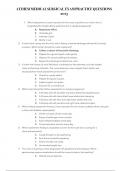-
1. Exam (elaborations) - Hesi rn medical surgical exit exam 2023/2024 v1 (don’t forget answer key on the las...
-
2. Exam (elaborations) - Updated hesi exit exam 2023: medical surgical questions
-
3. Exam (elaborations) - Hesi rn medical surgical 55 exam questions v1
-
4. Exam (elaborations) - 2022 hesi med surg exit exam (version 1) test bank
-
5. Exam (elaborations) - Hesi medical surgical 2021 actual questions and answers
-
6. Exam (elaborations) - Hesi critical care exam preparations
-
7. Exam (elaborations) - Hesi medical surgical version 1 2020/2021 questions and answers graded a
-
8. Exam (elaborations) - Hesi medical surgical exams version 4 test
-
9. Exam (elaborations) - Hesi medical surgical study guide 2023 - hematemesis information nursing processes
-
10. Exam (elaborations) - Hesi rn medical surgical study guide 2023-2024
-
11. Exam (elaborations) - Hesi rn ob maternity final exam 2 questions and answers 2023
-
12. Exam (elaborations) - 2022 hesi maternity ob final exam version 2 test
-
13. Exam (elaborations) - 2022 hesi ob maternity exam version 1 a grade with updated questions and answers
-
14. Exam (elaborations) - Hesi ob 2023/ 2024 exam questions and answers
-
15. Exam (elaborations) - Hesi ob exam guide and notes- green book exam notes
-
16. Exam (elaborations) - Hesi ob fundmentals of nursing exams 2023
-
17. Exam (elaborations) - Hesi ob maternity exam 2 revised questions with solutions 2022-2024
-
18. Exam (elaborations) - Hesi ob maternity exam 2020
-
19. Exam (elaborations) - Hesi ob maternity exams with correct answers -2020
-
20. Exam (elaborations) - Hesi ob maternity final exams 2023 with updated questions and answers - 100% guarante...
-
21. Exam (elaborations) - Hesi ob revised questions and answers updated
-
22. Exam (elaborations) - Ati capstone elsevier hesi medical surgical- disease management i | secondary prevent...
-
23. Exam (elaborations) - Ati capstone hesi exit maternity ob exam version 1 2023 questions and answers
-
24. Exam (elaborations) - Ati hesi medical surgical exam practice questions 2023
-
25. Exam (elaborations) - Hesi exit exam 2022 - medical surgical questions and answers with detailed explanatio...
-
26. Exam (elaborations) - Hesi exit exams 2018 - rn medical surgical questions and answers
-
27. Exam (elaborations) - Hesi exit exams- medical surgical exam 2 final exam questions and answers (in bold)
-
28. Exam (elaborations) - Hesi exit retake exams 2020/2021 - medical surgical retake exams 2020-2021- 100% veri...
-
29. Exam (elaborations) - Hesi medical surgical final exit exam 2 -2023
-
30. Exam (elaborations) - Hesi medical surgical test bank exams -ms4 2023/ 2024
-
31. Exam (elaborations) - New generation nclex- hesi ob pediatrics exam notes and exam preparation guide
-
32. Exam (elaborations) - Ngn hesi maternity exam with highlighted answers | real exams
-
33. Exam (elaborations) - 2020 hesi maternity exam test bank with updated answers | real exams
-
34. Exam (elaborations) - Ati comprehensive hesi maternity question and answers | real exams
-
35. Exam (elaborations) - Nclex hesi ob notes and study guides for maternal and child ob peds
-
36. Exam (elaborations) - New generation ati comprehensive hesi exam for pharmacology | real exams with rationa...
-
37. Exam (elaborations) - New generation ati comprehensive hesi exams 2023 | real exams with correct answers
-
38. Exam (elaborations) - New generation ati comprehensive hesi medical surgical assessment | real final exam
-
39. Exam (elaborations) - New generation comprehensive hesi exams for pregnancy, labor, childbirth, and postpar...
-
40. Exam (elaborations) - New generation hesi pathophysiology test bank with correct answers | real exams
-
41. Exam (elaborations) - Ngn new generation hesi ob maternity version 1 exams 2022 | real exams (real pictures...
-
42. Exam (elaborations) - Updated 2022 hesi maternity pediatric exam test bank | real exam with answer key in t...
-
43. Exam (elaborations) - Updated hesi exam preparation notes, hints, and study guide for maternal exams
-
44. Exam (elaborations) - New generation hesi nclex comprehensive exit exam | ati nursing exit exam 2023- 2024 ...
-
45. Exam (elaborations) - New hesi exam notes for caci endocrine disorders | gate pass to grade a | verified ex...
-
46. Exam (elaborations) - Hesi computerized adaptive testing (cat) test bank with rationales.
-
47. Exam (elaborations) - Hesi community health proctored exams- all versions -correct answers highlighted-
-
48. Exam (elaborations) - Hesi medical surgical exam- updated with 2023- 2024 questions and correct answers
-
49. Exam (elaborations) - Hesi med surg exams - new gen questions and answers dka questions included
-
50. Exam (elaborations) - Hesi med surg rn v1 exam- complete questions and answers
-
51. Exam (elaborations) - Hesi med surg form a & b- latest questions and answers
-
Show more




